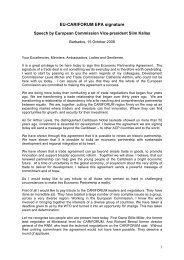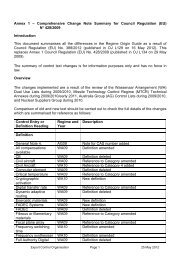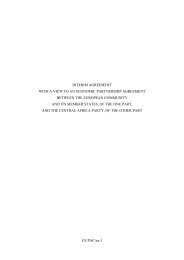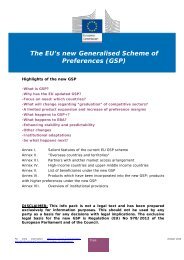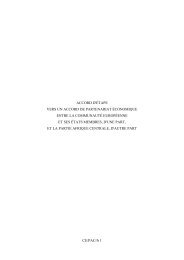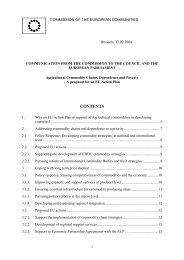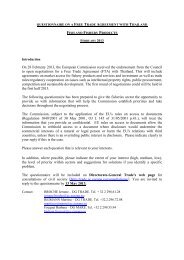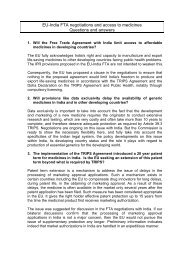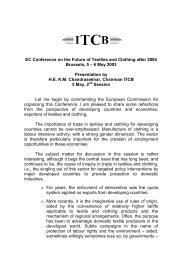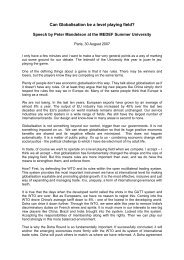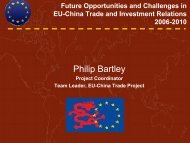Report on the Implementation of the derogation to ... - Trade Websites
Report on the Implementation of the derogation to ... - Trade Websites
Report on the Implementation of the derogation to ... - Trade Websites
You also want an ePaper? Increase the reach of your titles
YUMPU automatically turns print PDFs into web optimized ePapers that Google loves.
Final <str<strong>on</strong>g>Report</str<strong>on</strong>g><br />
RoO Derogati<strong>on</strong> under <strong>the</strong> PACP-IEPA<br />
60,000 mt) were insufficient <strong>to</strong> meet demand <strong>to</strong> support marked expansi<strong>on</strong> in processing capacity.<br />
There has been an increase in AW catch since 2008, <strong>to</strong> almost 100,000 mt in 2009, but with <strong>the</strong><br />
advent <strong>of</strong> <strong>the</strong> global sourcing derogati<strong>on</strong> and with PNG’s <strong>to</strong>tal processing volume remaining stable, it<br />
has not been necessary <strong>to</strong> fully utilize this increase in PNG processing plants. The AW catch<br />
decreased in 2010, despite <strong>the</strong> record catch in PNG waters.<br />
Following derogati<strong>on</strong> from <strong>the</strong> RoO (post March 2008), fish could potentially be obtained from a<br />
wider range <strong>of</strong> vessels (i.e. any vessels irrespective <strong>of</strong> vessel flag/ownership or fishing area).<br />
However, in practice, since vessels are also required <strong>to</strong> be SPS-compliant <strong>to</strong> access EU markets, this<br />
requirement may have initially served as a c<strong>on</strong>straint, as many purse seine vessels operating in<br />
WCPO waters did not have SPS certificates. A comparis<strong>on</strong> undertaken in March 2010 between <strong>the</strong><br />
number <strong>of</strong> purse seiners <strong>on</strong> <strong>the</strong> FFA Regi<strong>on</strong>al Vessel Register and <strong>the</strong> number <strong>of</strong> vessels <strong>on</strong> both <strong>the</strong><br />
vessel register and <strong>the</strong> DG SANCO list, found that <strong>on</strong>ly 39% <strong>of</strong> vessels were SPS compliant. Only<br />
three fleets were in a positi<strong>on</strong> <strong>to</strong> supply significant quantities <strong>of</strong> EU-compliant fish for processing and<br />
export <strong>to</strong> <strong>the</strong> EU market – Philippines (15/18 vessels), Korea (26/27) and Taiwan (17/33). Smaller<br />
volumes were also potentially available from China (3/12), Ecuador (7/7), El Salvador (2/2), Spain<br />
(4/4) and New Zealand (2/4). 229 Japan (1/36), USA (5/37) and Vanuatu (0/19, with no SPS or IUU CA)<br />
were not in a positi<strong>on</strong> <strong>to</strong> supply significant amounts <strong>of</strong> raw materials for <strong>the</strong> EU market. Central <strong>to</strong><br />
estimating how much fish would actually be available <strong>to</strong> supply EU markets would be an<br />
understanding <strong>of</strong> vessels’ existing supply c<strong>on</strong>tracts/arrangements with trading firms and processing<br />
firms, including own plants for those vessels bel<strong>on</strong>ging <strong>to</strong> vertically integrated companies with tuna<br />
processing interests (refer <strong>to</strong> Secti<strong>on</strong> 6 for fur<strong>the</strong>r discussi<strong>on</strong>).<br />
An update <strong>of</strong> this analysis (Oc<strong>to</strong>ber 2011) is presented in Table 5.7, as well as 2010 catch data and<br />
volumes/destinati<strong>on</strong>s <strong>of</strong> fish for processing. It is clear that <strong>the</strong>re has been a marked increase in <strong>the</strong><br />
number <strong>of</strong> vessels <strong>on</strong> DG SANCO lists (i.e. an additi<strong>on</strong>al 48 vessels) and, in turn, <strong>the</strong> volume <strong>of</strong> SPScompliant<br />
fish potentially available for processing (Table 5.7). Over 50% <strong>of</strong> <strong>the</strong> 263 purse seine<br />
vessels listed in <strong>the</strong> FFA Regi<strong>on</strong>al Vessel Register are now <strong>on</strong> DG SANCO lists compared <strong>to</strong> 39% in<br />
2010. Apart from <strong>the</strong> more complete listing <strong>of</strong> Philippine vessels <strong>on</strong> <strong>the</strong> FFA register, <strong>the</strong> biggest<br />
change is seen in Japanese vessels, with 26/36 vessels now listed, compared <strong>to</strong> <strong>on</strong>ly <strong>on</strong>e vessel in<br />
2010.<br />
As noted above, it is unknown what volume <strong>of</strong> fish caught by <strong>the</strong>se vessels might be available <strong>to</strong> PNG<br />
processors in light <strong>of</strong> existing supply c<strong>on</strong>tracts and arrangements, but a rough proporti<strong>on</strong>al estimate<br />
from Table 5.7 suggests that as much as 760,000 mt <strong>of</strong> compliant fish was potentially available from<br />
<strong>the</strong> 2010 purse seine producti<strong>on</strong>. Countries with <strong>the</strong> largest quantities <strong>of</strong> SPS-compliant fish at this<br />
time include Japan, Korea, Taiwan and PNG/Philippines. The Japanese catch is largely committed <strong>to</strong><br />
domestic use (canning, katsuobushi), with small (but increasing) increasing volumes sent <strong>to</strong> Thailand<br />
230<br />
(~20,000 mt). Much <strong>of</strong> <strong>the</strong> Korean catch (277,000 mt in 2010) is currently supplied <strong>to</strong> its own<br />
domestic canneries (120,000 mt), and <strong>to</strong> Thailand (90,000 mt), while Taiwan is <strong>the</strong> largest supplier <strong>to</strong><br />
Thailand <strong>of</strong> all fleets operating in <strong>the</strong> WCPO (198,000 mt, accounting for nearly all <strong>of</strong> its producti<strong>on</strong>).<br />
The catch <strong>of</strong> Philippines domestic vessels mostly goes <strong>to</strong> its own canneries. PNG-based Philippines<br />
and Philippines distant water vessels fishing in PNG supply processing operati<strong>on</strong>s in both Philippines<br />
and PNG.<br />
Ind<strong>on</strong>esian catch is not included in <strong>the</strong> table, since Ind<strong>on</strong>esian vessels are not required <strong>to</strong> be <strong>on</strong> <strong>the</strong><br />
FFA RVR. However, it should be noted that Ind<strong>on</strong>esia is a major WCPO producer and existing<br />
229 Oceanic Développement 2010.<br />
230 Hamilt<strong>on</strong> et al. 2011.<br />
Linpico s.a.r.l. Page 117




